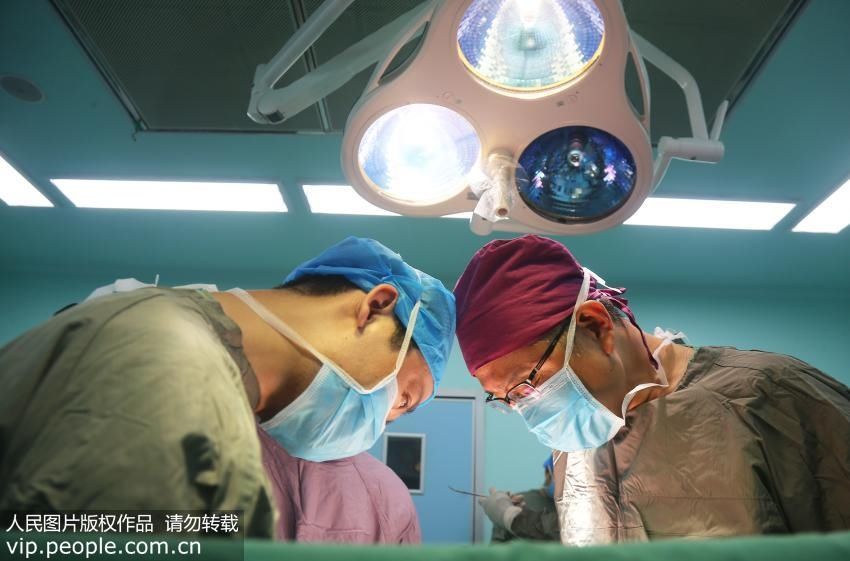For many people, a fractured rib is a relatively unfamiliar condition. It sounds scary, and there are even reports of “a man coughing and breaking a rib”. In fact, for osteoporosis patients, this kind of thing really happens. What does a rib fracture look like? How to treat and recover after a fracture?

File photo: Medical staff perform surgery on a patient. (Cao Zhengping/People’s Picture)
[Disclaimer: All pictures with the words “People’s Picture” are copyrighted pictures, protected by law, and use (including reprint) requires payment, please call to buy: 010-65368384 or 021-63519288. ]
What are the causes of rib fractures?
A rib is a long, curved bone that is relatively thin and therefore prone to fracture in the event of a bump. The reasons for rib fractures are generally divided into two types: one is trauma, such as in a traffic accident, the chest hits the handlebar or steering wheel. The second is severe coughing, especially for patients with osteoporosis, severe or prolonged coughing may cause rib fractures. In addition, the elderly are also prone to fractures. If they accidentally slip and fall to the ground, they may also cause fractures.
The symptoms of a rib fracture are related to the extent of the fracture. Fractures of a single rib or one rib are mainly manifested as chest pain, and the pain will worsen when breathing; multiple rib fractures, the pain felt by the patient will be so severe that they dare not breathe, resulting in a feeling of suffocation; the most serious is multiple rib fractures With multiple rib fractures, the patient’s breathing is abnormal, the thorax shrinks during inhalation, and expands during exhalation, resulting in a “flail chest” phenomenon.
If a rib fracture is misplaced and the end of the fracture punctures the lung, it can cause a “pneumothorax,” in which air from the lungs enters the chest cavity. One of these is called tension pneumothorax, which compresses the lungs, causing the gas to only get in and out, making the patient unable to breathe, which is more dangerous. In addition, if the fracture end punctures the blood vessel, there will be thoracic hemorrhage, and if the amount of bleeding is large, shock symptoms may even occur.
How is a fractured rib treated?
The fractured end of the rib is less pronounced relative to the fracture of the extremity. Lesser rib fractures may have very small sutures, especially in the early stages, and may not always be visible on X-ray or CT. But this does not mean that there is no solution. If there is no obvious fracture seam, the patient’s pain is very strong. At this time, the doctor will give some conservative symptomatic treatment. After a week or two, if the patient is still in great pain, a follow-up examination can be done. Because in about two weeks after the fracture, the fracture suture becomes obvious with the resorption of the bone, and it is easier to make a diagnosis by taking a film at this time.
In the case of a single, nondisplaced rib fracture, a doctor’s approach is generally conservative. At this time, the patient’s symptoms are mainly pain, so the first step is to relieve the pain and let the patient take painkillers. At the same time, immobilize the patient’s chest with a chest strap. If there are multiple, multiple or significantly dislocated rib fractures, a “flail chest” phenomenon, or complications such as bleeding and “pneumothorax” caused by the fracture end puncturing the pleura, lungs or blood vessels, the doctor will recommend do surgery. During the operation, the doctor will reduce the fractured part and fix it with a small plate to reduce the patient’s pain and the possibility of complications such as pneumothorax and bleeding.
Other than that, can rib fractures heal on their own? As the saying goes, it takes a long time for a broken rib to heal, and people often dare not breathe heavily due to the pain. In the long run, people with lung disease or the elderly may develop lung infection, inflammation and even abscesses, especially the elderly, may develop chronic diseases and even life-threatening. Therefore, early intervention and early treatment are needed for these groups.
What should I look out for after a rib fracture?
1. Postoperative rehabilitation training
After the operation, the patient can receive some formal rehabilitation training. For complications, the doctor will recommend the patient to do deep breathing training, or balloon training. In this process, the lungs are fully expanded, reducing the probability of complications such as pneumonia and lung abscesses, and promoting the recovery of fractures.
2. Comfortable position
For patients with rib fractures, there is no specific position for sleeping. It can relieve pain and increase comfort.
3. Avoid strenuous exercise
Patients with rib fractures do not need to lie in bed all the time, they can do light and appropriate activities, but they should avoid lifting things with force and chest expansion. Vigorous exercise that moves the upper body.
Interviewed expert: Gao Zhiguang, Deputy Chief Physician of Emergency Trauma Surgery, Shanghai Oriental Hospital
Column Support: Emergency Trauma Surgery, Shanghai Oriental Hospital
Editor: Zhou Weihua